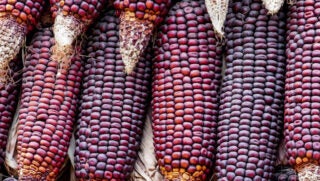Did you know that the cut-flower market is a booming agricultural product in the U.S.? (I mean, at least prior to reading the headline on this article.)
We don’t often think of those beautiful farmers market bouquets of zinnias, sunflowers, and larkspur as cash crop or agricultural product. However, cut flowers are in fact one of the most profitable crops you can grow, with growers across the United States reporting sales of $25,000 to $30,000 per acre! Cut flowers are one of the best cash crops for small growers all across North America, where most growers start part-time, growing for local markets like farmers markets, independent florists, and farm-to-table restaurants.
The Association of Specialty Cut Flower Growers supports this growing industry segment by promoting resources about locally grown cut flowers and provides a searchable list of local growers from all over the country.
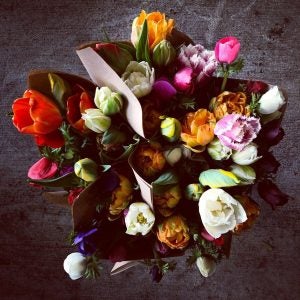
While looking deeper into this beautiful topic (pun intended), all indicators show that the pandemic brought a surprise boost for local businesses centered around floral agriculture! Bloomberg reported in 2021 that consumers were willing to spend significant dollars during the pandemic to beautify their homes — since they were now home more to enjoy them!
The U.S. Department of Agriculture tracks this agricultural product, also, and reported that 80 percent of the cut flowers purchased in the U.S. are still imported, but the value of domestic floriculture rose 9 percent from 2015 to $4.77 billion in 2018. Additionally, the number of producers increased 8 percent between 2015 and 2018 — and keeps growing!
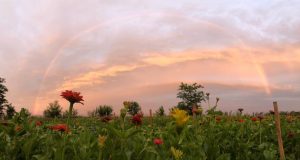
Cut flowers are a great cash crop because they are easy to grow, can produce quickly, and when you diversify your plantings, they supply a good income throughout the growing season. Even backyard gardeners with some space can grow quite a few flowers in a compact area to get started.
Startup costs are usually fairly low as well because most green-thumb types already have the necessary basic garden tools and only need to invest in seed to get started. Many experienced growers say that local farmers markets are the best place for a beginner to get started so more time can be devoted to caring for the crop.
Maggie Taylor, owner of Delight Flower Farm in Champaign, Illinois, is one example of the growing number of “farmer-florists” throughout the U.S. She grows a wide variety of cut flowers for the region’s floral needs. She offers services including wedding flowers, CSA memberships, wholesale, farmers market sales, and business subscriptions. Her farm also grows edible flowers and medicinal herbs and sells evergreen wreaths in winter.
In addition to the tangible product sales, Taylor diversifies her operation by teaching a variety of workshops throughout the year on flower arranging, yoga, herbalism, homesteading, decorative arts, and more. Taylor prides herself on the quality of her farm products and shared recently on her Facebook page, “Every flower we bring to market is harvested at a particular stage and with the utmost care to ensure you can enjoy them in the vase for as long as possible.”
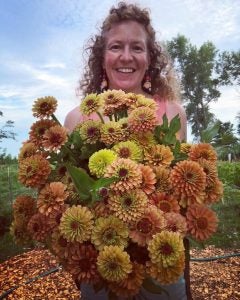
Veterans of the industry share that its typically best stick to proven cut flower varieties when starting out, so you have a better chance of selling out. Each area of the country has varying soil and climate, but some of the best-selling flower varieties are:
- Sunflowers
- Ageratum
- Dahlia
- Lavender
- Delphinium
- Zinnias
- Peony
- Scabiosa (Pincushion flower)
- Larkspur
- Snapdragon
- Verbena bonariensis (Tall Verbena)
- Salvia
- Yarrow
- Bells of Ireland
- Campanula
- Nigella or Love-in-a-mist
- Anemone
- Ranunculus
- Tulips
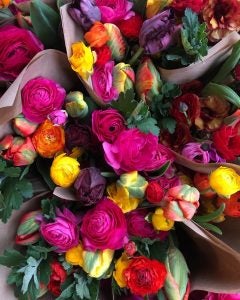
Be sure if you are thinking about taking this on as a hobby, secondary income or going into the full-time flower business, that you know your growing zone and soils and note that all of these come into maturity at different times throughout the season. Mixed bouquets seem to sell the best and allow you to blend in a variety of cut flowers so you don’t end up at the end of the day with too many unsold stems of individual varieties. Some growers use gypsophila (baby’s breath) as a bouquet filler because it is easy to grow and blends well with other flower varieties.
In addition to selling cut flowers at a local market, here are some other ways local flower farmers sell their “pretties”:
- U-Cut/U-Pick Flower Patch — much like the U-pick berry patches, these become a destination location for locals to go for a fun outing as well as the opportunity to take home a beautiful bouquet or two! Agri-tourism at it’s best!
- Roadside Stands — already-picked flowers are good for those in a hurry or for those that don’t want people out and about in the main growing area.
- Weddings and Events sales — can be profitable but also takes time to build relationships with local florists and event planners.
- Restaurants/Hotels/Event facilities — oftentimes upscale restaurants and hotels use cut flower arrangements to decorate for special occasions such as banquets or special events. Special event facilities may provide “preferred vendor” lists to clients — and you want to be on it!
- Independent florists — local independent florists may be interested especially for weddings and other special events since you may have unique things they can’t buy on the wholesale market.
- Chefs — they like edible flowers and commonly use specialty flowers to enhance taste and visual appeal of a fine meal. There are many farm-to-table type restaurants popping up that would likely be interested!
- Subscription sales/CSAs — this is a great way to create a steady income from a flower harvest! These can be weekly, bi-monthly or monthly shares/subscriptions — offices and personal homes like this idea to brighten up a room or two on a continual basis.
- Independent grocers — these are great to work with! The easiest way to sell to independent grocers is to provide stock of cut flowers/bouquets as a consigner.
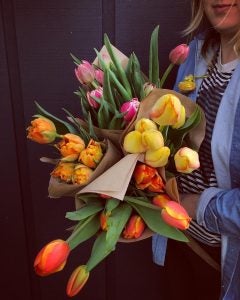
The Association of Specialty Cut Flower Growers encourages you to consider buying from a local grower because, “Local flowers are grown here in North America, and often may be cut in the morning, and decorating your dinner table that evening. Supporting our local farmers and merchants is good for every community.”
To get that dreamy Instagram-look bouquet you desire, local growers can offer you options in beautiful shades of a watercolor palette that you can’t get elsewhere!
So the next time you are looking for that special gift to make someone’s day, want to decorate for a special occasion, or “just because,” consider checking out local farmer-florists in your area for some of the freshest and finest blooms around!
Michelle Miller, the Farm Babe, is a farmer, public speaker and writer who has worked for years with row crops, beef cattle, and sheep. She believes education is key in bridging the gap between farmers and consumers.

